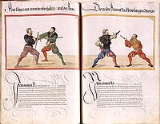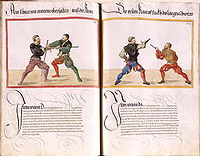
Paulus Hector Mair
Encyclopedia
Paulus Hector Mair was an Augsburg
civil servant, and active in the martial arts of his time
. He collected Fechtbücher
and undertook to compile all knowledge of the art of fencing in a compendium surpassing all earlier books. For this, he engaged the painter Jörg Breu the Younger
, as well as two experienced fencers, whom he charged with perfecting the techniques before they were painted. The project was very costly, taking full four years, and according to Mair, consumed most of his family's income and property. Three versions of his compilation, and one later, less extensive manuscript, have been preserved.
Not only did Mair spend huge sums on his collections and on his projects, he also had a very expensive lifestyle, frequently hosting receptions for the more important burghers of Augsburg. His own income was not sufficient for this, and during many years, he misappropriated funds from the city treasury, with the supervision of which he had been entrusted since 1541. His embezzlement
s were discovered in 1579, and Mair was hanged as a thief at the age of 62.
 Mair compiled a voluminous, encyclopedic compendium of the martial arts of his time
Mair compiled a voluminous, encyclopedic compendium of the martial arts of his time
, collected in 16 books in two volumes. The compendium survives in three manuscript copies. The subject matter treated is:
Volume 1:
Volume 2:
Augsburg
Augsburg is a city in the south-west of Bavaria, Germany. It is a university town and home of the Regierungsbezirk Schwaben and the Bezirk Schwaben. Augsburg is an urban district and home to the institutions of the Landkreis Augsburg. It is, as of 2008, the third-largest city in Bavaria with a...
civil servant, and active in the martial arts of his time
Historical European martial arts
Historical European martial arts is a neologism describing martial arts of European origin, used particularly to refer to arts formerly practised, but having since died out or evolved into very different forms...
. He collected Fechtbücher
Fechtbuch
Martial arts manuals are instructions, with or without illustrations, detailing specific techniques of martial arts.Prose descriptions of martial arts techniques appear late within the history of literature, due to the inherent difficulties of describing a technique rather than just demonstrating...
and undertook to compile all knowledge of the art of fencing in a compendium surpassing all earlier books. For this, he engaged the painter Jörg Breu the Younger
Jörg Breu the Younger
Jörg Breu the Younger , son of Jörg Breu the Elder, was a painter of Augsburg.In the 1540s, he was involved with the creation of the Fechtbucher commissioned by Paulus Hector Mair....
, as well as two experienced fencers, whom he charged with perfecting the techniques before they were painted. The project was very costly, taking full four years, and according to Mair, consumed most of his family's income and property. Three versions of his compilation, and one later, less extensive manuscript, have been preserved.
Not only did Mair spend huge sums on his collections and on his projects, he also had a very expensive lifestyle, frequently hosting receptions for the more important burghers of Augsburg. His own income was not sufficient for this, and during many years, he misappropriated funds from the city treasury, with the supervision of which he had been entrusted since 1541. His embezzlement
Embezzlement
Embezzlement is the act of dishonestly appropriating or secreting assets by one or more individuals to whom such assets have been entrusted....
s were discovered in 1579, and Mair was hanged as a thief at the age of 62.
Martial arts compendium

Historical European martial arts
Historical European martial arts is a neologism describing martial arts of European origin, used particularly to refer to arts formerly practised, but having since died out or evolved into very different forms...
, collected in 16 books in two volumes. The compendium survives in three manuscript copies. The subject matter treated is:
Volume 1:
- A. German longswordGerman school of fencingThe German school of fencing is the historical system of combat taught in the Holy Roman Empire in the Late Medieval, Renaissance and Early Modern periods , as described in the Fechtbücher written at the time...
- B. DussackDussackA Dussack is a type of short, single-edged sword from Central and Eastern Europe ....
(backsword) - C. StaffStick fightingStick fighting is a generic term for martial arts which use simple long slender, blunt, hand-held, generally wooden 'sticks' for fighting such as a staff, cane, walking stick, baton or similar....
- D. PikePike (weapon)A pike is a pole weapon, a very long thrusting spear used extensively by infantry both for attacks on enemy foot soldiers and as a counter-measure against cavalry assaults. Unlike many similar weapons, the pike is not intended to be thrown. Pikes were used regularly in European warfare from the...
- E. HalberdHalberdA halberd is a two-handed pole weapon that came to prominent use during the 14th and 15th centuries. Possibly the word halberd comes from the German words Halm , and Barte - in modern-day German, the weapon is called Hellebarde. The halberd consists of an axe blade topped with a spike mounted on...
- F. Fighting with the scytheScytheA scythe is an agricultural hand tool for mowing grass, or reaping crops. It was largely replaced by horse-drawn and then tractor machinery, but is still used in some areas of Europe and Asia. The Grim Reaper is often depicted carrying or wielding a scythe...
- G. Fighting with the sickleSickleA sickle is a hand-held agricultural tool with a variously curved blade typically used for harvesting grain crops or cutting succulent forage chiefly for feeding livestock . Sickles have also been used as weapons, either in their original form or in various derivations.The diversity of sickles that...
- H. Unarmed combat (wrestlingWrestlingWrestling is a form of grappling type techniques such as clinch fighting, throws and takedowns, joint locks, pins and other grappling holds. A wrestling bout is a physical competition, between two competitors or sparring partners, who attempt to gain and maintain a superior position...
)
Volume 2:
- I. DaggerDaggerA dagger is a fighting knife with a sharp point designed or capable of being used as a thrusting or stabbing weapon. The design dates to human prehistory, and daggers have been used throughout human experience to the modern day in close combat confrontations...
- K. Spanish rapierDestrezaLa Verdadera Destreza is a Spanish system of fencing. The word "destreza" literally means "skill." However, the full name is perhaps best translated as "the true art."...
- L. Battle axeBattle axeA battle axe is an axe specifically designed for combat. Battle axes were specialized versions of utility axes...
- M. Joust, mounted combat for sport
- N. TournamentTournament (medieval)A tournament, or tourney is the name popularly given to chivalrous competitions or mock fights of the Middle Ages and Renaissance . It is one of various types of hastiludes....
history and rules - O. Judicial combatTrial by combatTrial by combat was a method of Germanic law to settle accusations in the absence of witnesses or a confession, in which two parties in dispute fought in single combat; the winner of the fight was proclaimed to be right. In essence, it is a judicially sanctioned duel...
- P. Mounted combat, serious (self-defense)
- Q. Fencing in plate armourPlate armourPlate armour is a historical type of personal armour made from iron or steel plates.While there are early predecessors such the Roman-era lorica segmentata, full plate armour developed in Europe during the Late Middle Ages, especially in the context of the Hundred Years' War, from the coat of...
(shield, spear, longsword)
Manuscripts
- three copies of the compendium, in two volumes each:
- German version: SaxonSaxonyThe Free State of Saxony is a landlocked state of Germany, contingent with Brandenburg, Saxony Anhalt, Thuringia, Bavaria, the Czech Republic and Poland. It is the tenth-largest German state in area, with of Germany's sixteen states....
state library, DresdenDresdenDresden is the capital city of the Free State of Saxony in Germany. It is situated in a valley on the River Elbe, near the Czech border. The Dresden conurbation is part of the Saxon Triangle metropolitan area....
, Mscr. Dresd. C 93/94, after 1542, two volumes, 244+328 folia. - LatinLatinLatin is an Italic language originally spoken in Latium and Ancient Rome. It, along with most European languages, is a descendant of the ancient Proto-Indo-European language. Although it is considered a dead language, a number of scholars and members of the Christian clergy speak it fluently, and...
version: BavariaBavariaBavaria, formally the Free State of Bavaria is a state of Germany, located in the southeast of Germany. With an area of , it is the largest state by area, forming almost 20% of the total land area of Germany...
n state library, München cod. icon 393, after 1542, two volumes, 309+303 folia. This is the most luxurious production of Mair's, and he sold it to duke Albert V. of Bavaria, allegedly for the enormous sum of 800 fl., in 1567 (- online facsimiles: De arte athletica Tome I, De arte athletica Tome II, daten.digitale-sammlungen.de
- bilingual Latin-German version: AustriaAustriaAustria , officially the Republic of Austria , is a landlocked country of roughly 8.4 million people in Central Europe. It is bordered by the Czech Republic and Germany to the north, Slovakia and Hungary to the east, Slovenia and Italy to the south, and Switzerland and Liechtenstein to the...
n national library, ViennaViennaVienna is the capital and largest city of the Republic of Austria and one of the nine states of Austria. Vienna is Austria's primary city, with a population of about 1.723 million , and is by far the largest city in Austria, as well as its cultural, economic, and political centre...
, Codex Vindobensis 10825/26 after 1542, two volumes, 270+343 folia.- online facsimiles: microfilm scans (thearma.org)
- German version: Saxon
- Jörg BreuJörg Breu the YoungerJörg Breu the Younger , son of Jörg Breu the Elder, was a painter of Augsburg.In the 1540s, he was involved with the creation of the Fechtbucher commissioned by Paulus Hector Mair....
Sketchbook (Cod.I.6.2°.4), Augsburg city archive, Schätze B2 Reichsstadt, 1553, 110 folia, illustrated by Heinrich Vogtherr, based material acquired from Anthon Rast of Nürnberg (d. 1549).- online facsimile: media.bibliothek.uni-augsburg.de, gesellschaft-lichtenawers.eu
Literature
- Knight, David James and Brian Hunt. Polearms of Paulus Hector Mair . Paladin Press, 2008. ISBN 13: 978-1-58160-644-7.
See also
- Historical European Martial ArtsHistorical European martial artsHistorical European martial arts is a neologism describing martial arts of European origin, used particularly to refer to arts formerly practised, but having since died out or evolved into very different forms...
- German school of swordsmanshipGerman school of swordsmanshipThe German school of fencing is the historical system of combat taught in the Holy Roman Empire in the Late Medieval, Renaissance and Early Modern periods , as described in the Fechtbücher written at the time...

